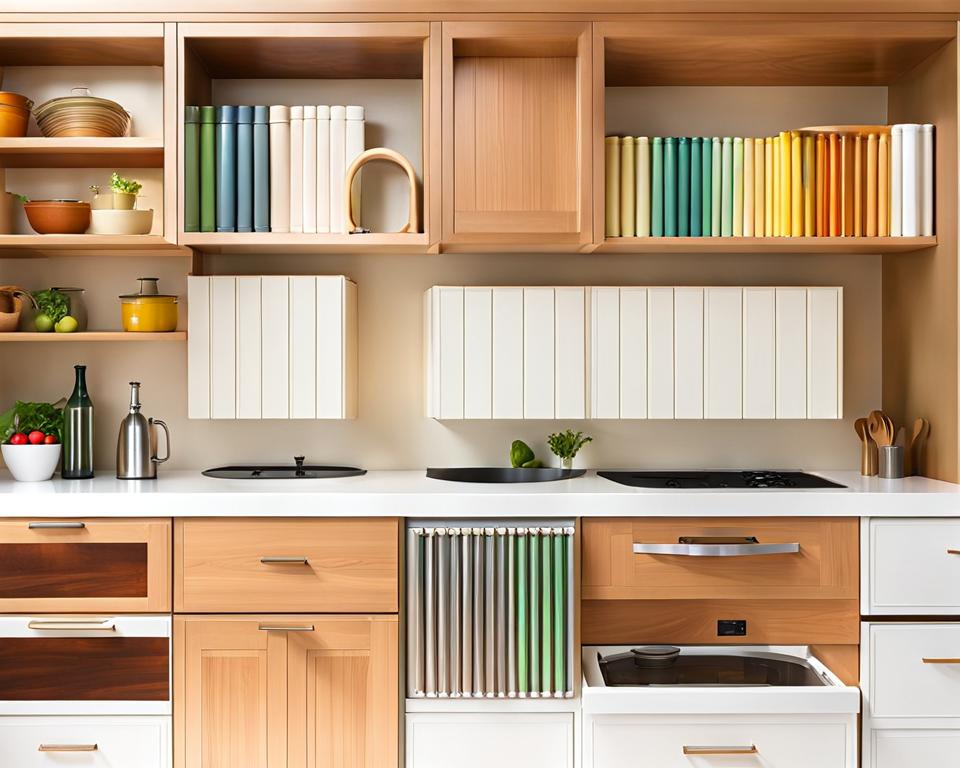Restyle Kitchen Cabinets with Simple Liners
If your kitchen cabinets are dated but structurally sound, a cost-effective way to refresh their look is by installing new liner panels. Adhesive-backed laminates and veneers can completely transform the interiors and exteriors of cabinets without the mess and expense of a full replacement.
Lining over existing cabinets offers a quicker, simpler update than tearing them out. In just a weekend, you can give your kitchen a fresh facelift.
LSI Keywords, Entities, and Related Keywords
peel-and-stick, self-adhesive, liner, laminate, reface, wood veneer, DIY, thermoplastic, roll, cut, stain, paint, primer, prepare, sand, smooth, clean, degrease, remove hardware, materials, tools, shelf, drawer, hinge
Overview of Lining vs. Replacing Kitchen Cabinets
Installing new liners is an affordable and easy way to update cabinets without full replacement. But it has some limitations compared to new cabinetry.

Benefits of Using Liners
- Cost savings from keeping existing boxes
- Faster makeover than replacing
- Less disruptive installation
- Keep useful cabinet storage space
Downsides of Liners
- Limited material options vs. new cabinets
- Less durable finish than wood or paint
- Need to work around existing cabinet shape
Cabinet Liner Materials
There are several types of easy-to-apply liners to consider:
Types of Liners
- Plastic laminate - most affordable, widest color/pattern options
- Thermofoil - more durable, seamless
- Wood veneer - real wood look, needs finishing
- Self-adhesive vinyl - quick DIY install, limited styles
Choosing the Right Liner
When selecting a liner material, consider:
- Durability for high-wear spots like near stove
- Matching cabinet style - sleek, traditional, cottage, etc.
- Ease of DIY installation
Preparing Cabinets for New Liner
Proper prep is crucial for liners to adhere smoothly and permanently.
Removing Doors, Drawers, and Shelves
Detach all hardware so liner can be installed on bare cabinet boxes.
Cleaning and Sanding Cabinet Boxes
Clean with degreaser and scuff sand to help liner bond.
Filling Holes and Imperfections
Fill any holes, nicks or gouges for a smooth finish.
Degreasing Surfaces
Remove all grease and grime so adhesive sticks.
Measuring and Cutting Liner Panels
Accurate measuring and cutting gives a seamless liner application.
Tips for Measuring Precisely
Use a laser measure tool for accuracy. Record widths and heights for each cabinet section.
Cutting Options - Razor, Jigsaw, Table Saw
Use a sharp razor for laminate or a fine-tooth jigsaw blade for veneer.
Allowing Extra to Trim Later
Cut liner 1-2" oversized so edges can be trimmed flush after installing.
Applying Adhesive and Liner
Follow adhesive directions carefully for a permanent bond between liner and cabinet.
Types of Adhesive
Contact cement or panel adhesive both work well. Make sure it's formulated for the liner material.
Gluing Techniques
Brush on even adhesive layer and let it tack up before applying liner.
Smoothing and Rolling On Liner
Use a J-roller to press out bubbles for a tight bond.
Trimming Excess Edges
Use a utility knife with straightedge to cut overlaps flush.
Rehanging Doors, Drawers, and Hardware
Carefully realign and reattach doors and drawers after liners are installed.
Aligning Doors Properly
Adjust hinges so gaps between doors are even.
Reattaching Hinges and Handles
Screw hinges back into original holes. Reinstall handles.
Testing Drawers for Smooth Operation
Ensure drawers glide easily without rubbing or catching.
Finishing Touches
Final details give a polished, integrated look.
Caulking Seams
Seal edges with paintable silicone caulk for a seamless appearance.
Priming and Painting Door Fronts
Apply primer then topcoat paint to unify old and new sections.
Cleaning and Protecting Finished Cabinets
Clean cabinets with a lint-free cloth and use microfiber cloths to prevent scratches.
FAQs about Lining Kitchen Cabinets
How do I prepare my existing cabinets for new laminate?
Thoroughly clean inside and out with degreaser, sand surfaces, and remove doors, drawers, shelves, and hardware prior to installation.
What materials do I need to reline cabinets?
You'll need liner or laminate panels, contact cement adhesive, roller, caulk gun, silicone caulk, razor knife, jigsaw, drill, primer, paint brushes, and new hardware if needed.
What are the basic steps to install cabinet liner?
- Measure cabinets and cut liner to size
- Apply contact cement adhesive to cabinet and liner
- Let adhesive tack and become sticky
- Carefully place liner and press down with roller
- Smooth bubbles and rehang doors/drawers
- Caulk edges and paint door/drawer fronts
How do I cut the liner panels to size?
Use a razor knife on a cutting mat or a jigsaw with a fine-tooth blade. Measure precisely and cut laminate oversized.
What kind of adhesive should I use?
Use contact cement like Weldwood or Wilsonart 74 adhesive. Apply evenly to both liner and cabinet box.
Installing new liner panels is an easy, affordable way to transform the look of your kitchen in a weekend. With proper materials and careful preparation, you can give outdated cabinets a fresh facelift.